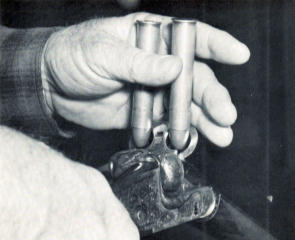

 The Accurate Reloading Forums
The Accurate Reloading Forums  THE ACCURATE RELOADING.COM FORUMS
THE ACCURATE RELOADING.COM FORUMS  Rifles
Rifles  Double Rifles
Double Rifles  Sealing wood for dummies
Sealing wood for dummiesGo  | New  | Find  | Notify  | Tools  | Reply  |  |
| One of Us |
Some of you may remember that the forend on my Chapuis 9.3 has warped, resulting in my regulation going all to hell (again). I have been so disgusted with the rifle I put it in the safe some 5 months ago and haven't fooled around with it since. Waiting for better weather and a better attitude on my part, I guess. Anyway, I took it out of the safe a couple of days ago and it appears that the winter weather (higher humidity) has resulted in the forend returning back to its original position, at least as near as I can tell visually. I'm going to have to go shoot it to see if it has returned even close to the former regulation before I start in shimming, etc. again. Immediately after I do that, I need to seal the wood. Other that Tru-Oil, which I have and have used, does anybody have anything else that is readily available that they would recommend? Unless I can get this problem fixed, the rifle is essentially useless. If I shim it so it is accurate in the summer, then it will be way off in the winter during hunting season up here, and vice versa if shimmed for summer. Hauling it off to Africa or Oz for a hunting trip would also be useless. By the time I had something in my sights, who knows where the d**n thing will be putting the left barrel? I've thought about having a new forend made up for it, but am afraid of the cost based on previous posts on this board. Still pi**sed in the NW. DuaneB Chapuis UGEX, 9.3X74R & 7X65R | ||
|
| One of Us |
My Chapuis developed hairline cracks on the rear of the forearm on each side. I removed the stress by sanding some clearence in the crack area. Opened the cracks on the inside with my Dremmel tool, layed in some bedding compound and resanded and sealed the sanded area with varnish. No more problem. | |||
|
| One of Us |
Neither of these problems should ever arise on a new production rifle. I'll defer to the experienced smiths here, but in my limited experience such problems arise when using blanks that have not been properly cured. Blanks need a fairly long drying period if done naturally. Something on the order of 5 to 7 years and up depending on the wood. You can speed that up by kiln drying, but in doing so you risk causing cracks in the blank due to the speed of the process. Moisture content is fairly easy to measure, and there are standards set for when a piece of wood is good to go. If the wood is still green, it will crack as it continues to dry. If you seal green wood, it will find a way to break the seal and crack. Surprising that this is happening on production models. SCI Life Member DSC Life Member | |||
|
| One of Us |
I collect and restore U.S. martial firearms. I have done many WWI rifle stocks, some of which were in pretty bad condition, including completely saturated with cosmoline and/or grease. After all the other involved work, I use MINWAX Natural 209 wood finish. It is a penetrating stain and sealer which will not alter the color but will highlight the grain. Once dry, an oil finish can be rubbed into the stock as desired. This is the only MINWAX product I use on rifle stocks. Don't forget to do the inside and underneath the grip-cap and recoil pad. Mike ______________ DSC DRSS (again) SCI Life NRA Life Sables Life Mzuri IPHA "To be a Marine is enough." | |||
|
| Powered by Social Strata |
| Please Wait. Your request is being processed... |
|
 The Accurate Reloading Forums
The Accurate Reloading Forums  THE ACCURATE RELOADING.COM FORUMS
THE ACCURATE RELOADING.COM FORUMS  Rifles
Rifles  Double Rifles
Double Rifles  Sealing wood for dummies
Sealing wood for dummies

Visit our on-line store for AR Memorabilia

